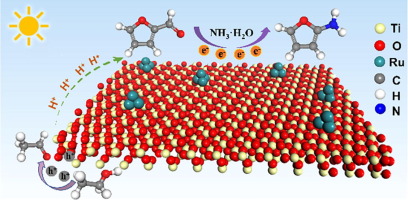79. Modulating the Coverage of Adsorbed Hydrogen via Hydrogen Spillover Enables Selective Electrocatalytic Hydrogenation of Phenol to Cyclohexanone
Yuanbo Liu, Kaiyue Ji, Xi Wang, Qiujin Shi, An-Zhen Li, Zhuoqun Yin, Prof. Yu-Quan Zhu, Prof. Haohong Duan*
Angew. Chemie. Int. Ed. 2024, e202419178
DOI: 10.1002/anie.202419178

Abstract
Selective electrocatalytic hydrogenation (ECH) of phenol is a sustainable route to produce cyclohexanone, an industrially important feedstock for polymer synthesis. However, attaining high selectivity and faradaic efficiency (FE) for cyclohexanone remain challenging, owning to over-hydrogenation of phenol to cyclohexanol and competition of hydrogen evolution reaction (HER). Herein, by employing hydrogen spillover effect, we modulate adsorbed hydrogen species (Hads) coverage on Pt surface via migration to TiO2 in an anatase TiO2-supported Pt catalyst. In ECH of phenol, a high selectivity (94 %) and good FE (63 %) for cyclohexanone are obtained, showing more advantageous performance compared with previous reports. Cyclic voltammetry (CV) tests and electrochemical Raman spectroscopy reveal that Hads migrated from Pt to TiO2. We propose that TiO2-induced hydrogen spillover contributes to low Hads coverage over Pt, which effectively hinders over-hydrogenation of cyclohexanone and HER. We establish a scaling relationship between the intensity of hydrogen spillover and cyclohexanone selectivity by varying the types of anatase TiO2, and show the universality of the strategy over other reducible metal oxides as the support (rutile TiO2, CeO2 and WO3). This work showcases an effective strategy for tuning hydrogenation selectivity in electro-catalysis, by taking advantage of thermo-catalytically well-documented hydrogen spillover effect.



